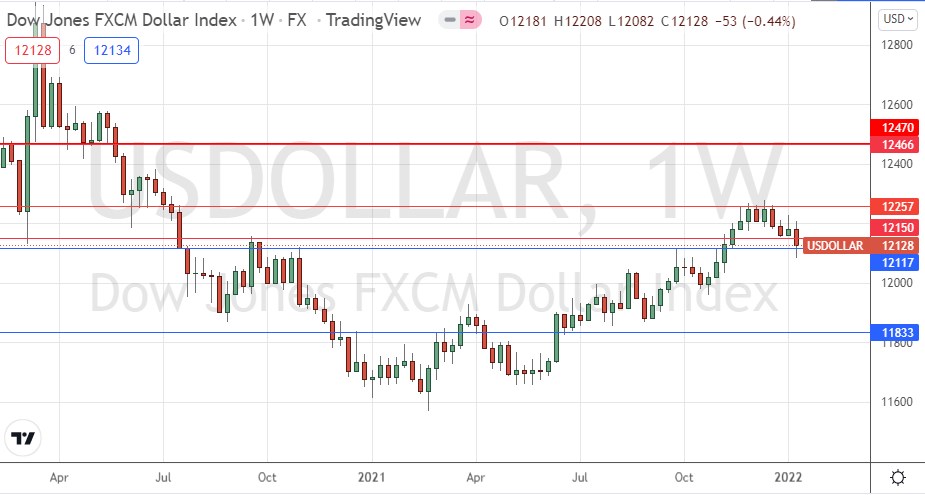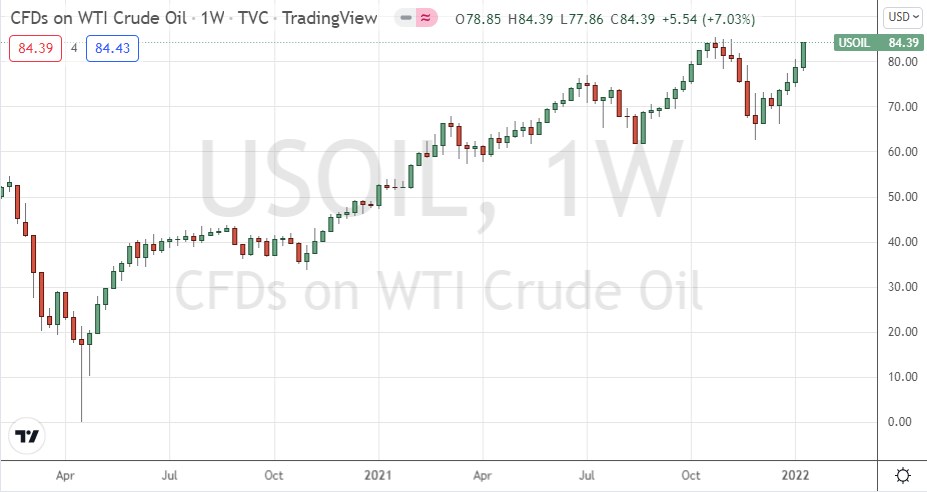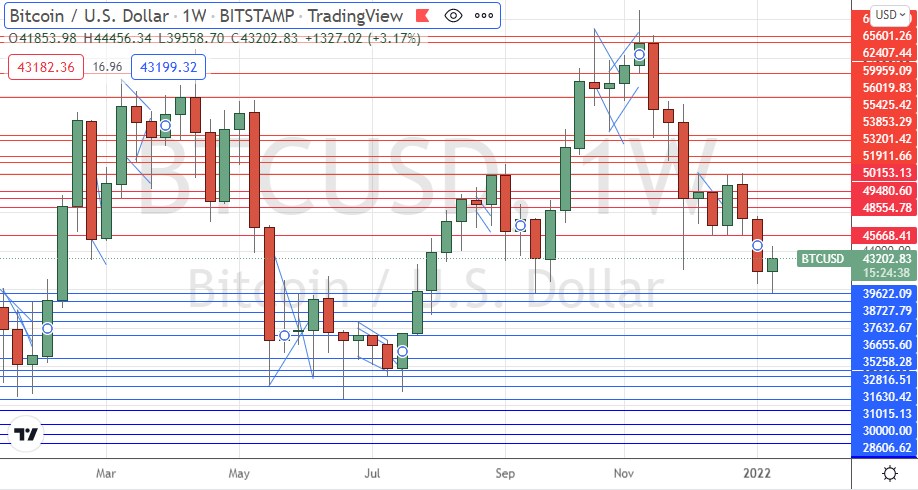The difference between success and failure in Forex trading is very likely to depend mostly upon which currency pairs you choose to trade each week and in which direction, and not on the exact trading methods you might use to determine trade entries and exits.
When starting the trading week, it is a good idea to look at the big picture of what is developing in the market as a whole and how such developments and affected by macro fundamentals and market sentiment.
Big Picture 16th January 2022
As the new calendar year has gotten underway, markets are souring compared to December’s broad bullishness on stocks and other risky assets. Last week saw most global stock markets fall, especially in the US, while the US dollar also sold off as a currency and not as part of a class of currencies, which is significant.
Last week was dominated by US treasury yields rising to reach new long-term highs, US inflation data which showed annualized inflation at a new 39-year high rate of 7%, and remarks from the Chair of the Federal Reserve Jerome Powell indicating that the Fed may act very quickly to run down its balance sheet. Friday also saw very poor US retail sales data which was much worse than expected. Although some of these factors could logically be taken to indicate a stronger US dollar, the market has clearly changed its sentiment on the greenback, which has been selling off as the weakest currency in the Forex market for some time.
Stock markets are mostly lower, and the Japanese yen has been one of the major gainers of the week. This is a typically bearish combination for the stock market and suggests that right now is not likely to be a great time to buy stocks, until this sentiment improves.
One asset that is behaving unusually considering the souring of risk sentiment is WTI Crude Oil, which continued to advance strongly over the past week and close just slightly below its multi-year high price.
The omicron coronavirus variant continues to spread extremely very quickly, sending new cases soaring to record highs. However, it appears the risk of severe disease is now considerably lower due to the nature of the variant and widespread vaccination, so it seems to not be hurting risk sentiment much although it has triggered new restrictions in many countries, especially in Europe.
I wrote in my previous piece last week that the best trades for the week were likely to be long of the USD/JPY currency pair following a daily (New York) close above 116.29 or short of BTC/USD following a daily (New York) close below $38,728. This was a good call as I was correct to wait for the specified breakouts before entering, which never came and therefore prevented what would have been losing trades.
Fundamental Analysis & Market Sentiment
The headline takeaways from last week were:
- The Chair of the Federal Reserve stated that the Fed may wind down its balance sheet earlier than expected, which was an unexpected hawkish tilt to US monetary policy.
- US CPI (inflation) data came in slightly higher than had been expected, at a month on month increase of 0.5% when only a 0.4% increase had been expected. This resulted in yet another increase in the headline annualized inflation rate to 7.0%, the highest rate seen since 1982.
- Very poor US retail sales data showing month on month retail sales fell by 1.9% when the figure had been expected to remain unchanged from the previous month.
- Global data continues to show that the fast-spreading omicron coronavirus variant is 70% less likely than previous strains to cause serious disease requiring hospitalization. This means that despite the massive spread of contagion, market sentiment is not really being affected as economies seem to be able to continue functioning without large scale disruption.
- The omicron coronavirus variant continues to spread very rapidly around the world. Several European countries and Canada have imposed restrictions on movement and new cases are reaching all-time records by far, with well over three million new confirmed cases currently being reported globally every day.
The coming week is likely to see a similar level of volatility to last week, with market direction possibly to be determined on Monday and Tuesday when Chinese GDP data and the Bank of Japan’s Outlook Report will be released. The only other truly major data releases due over this week are British and Canadian CPI (inflation) data which will be released Wednesday.
Last week saw the global number of confirmed new coronavirus cases rise to its highest level ever seen, with over 3.3 million new daily infections confirmed on Thursday. Approximately 59.7% of the global population has now received at least one vaccination.
The strongest growths in new confirmed coronavirus cases overall right now are happening in Albania, Algeria, Argentina, Australia, Austria, Bahrain, Barbados, Bosnia, Bulgaria, Chile, Colombia, Croatia, Cuba, Ecuador, Estonia, Finland, France, Germany, Guatemala, India, Israel, Italy, Jamaica, Japan, Kazakhstan, Latvia, Liechtenstein, Luxembourg, Mali, Mexico, Moldova, Mongolia, Morocco, Nepal, Netherlands, North Macedonia, Norway, Oman, Pakistan, Panama, Peru, Philippines, Portugal, Qatar, Romania, Saudi Arabia, Serbia, Singapore, Slovenia, Spain, Sweden, Switzerland, Tunisia, the UAE, the USA, Uruguay, and Uzbekistan.
Technical Analysis
U.S. Dollar Index
The weekly price chart below shows the U.S. Dollar Index printed a bearish candlestick last week, after previously rejecting the resistance level identified at 12257 four weeks ago. Although it is clear there is a short-term bearish trend in the US dollar, the weekly candlestick has a long lower wick rejecting the support level at 12117, although it convincingly broke below the higher former support level at 12150. While this decline is not enough to invalidate the long-term trend (the price is still well above its levels from 3 and 6 months ago), we may now have experienced a major bearish reversal.
Overall, it seems clear we have a mixed picture in the USD, long-term bullish, medium-term bearish, and short term indecisive at the support of 12117. The best I can say is that a sustained breakdown below 12117 during the coming week could be a decisively bearish sign for the dollar over the short to medium terms.
WTI Crude Oil
WTI Crude Oil made its highest weekly close in 7 years last week, printing a very strongly bullish wide-range candlestick which closed right on its high. These are bullish signs, as is the fact that a few other commodities are reaching long-term highs in a high dollar inflation environment. However, we did see higher prices a few weeks ago, so there may be a bearish failure below $85.39 which has not yet been reached. I think WTI Crude Oil can be an interesting buy once if we see a daily (New York) close above $85.39.
BTC/USD
Bitcoin printed a small bullish candlestick last week suggesting the price may have found support at about $40k. This may be significant as it can be seen in the price chart below that the area at $40k was also supportive the last time there was a multi-week selloff in Bitcoin, so we may have seen long-term buying here which could signify a trend change and see Bitcoin begin to take off again. This could be the completion of a bullish double bottom candlestick pattern,
Bitcoin bulls were encouraged last week showing option buying when the price firmed up around $40k. However, the current weekly candlestick is small and not especially strong, so it may be prudent for bulls to wait and see whether the nearest resistance level at $45,668 gets broken to the upside before entering any long-term long trades in favor of Bitcoin.
Bottom Line
I see the best opportunities in the financial markets this week as likely to be long of WTI Crude Oil following a daily (New York) close above $85.39 or long of BTC/USD following a daily (New York) close above $45,668.




